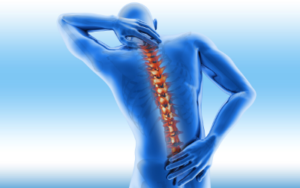
If you’ve already tried more conservative treatment options and still aren’t getting the relief you need, you’re likely considering spine surgery as your next step.
Typically, back surgery procedures are reserved for debilitating pain and numbness experienced as a result of compressed nerves in the spinal column. Moreover, spine surgery is often a last-resort option. That being said, sometimes it is also the best option.
Invasive surgical procedures are always quite intimidating to consider. So we know that making a final decision can be difficult for suffering patients as well.
Because of that, this post is going to take a look at two of the most common scenarios in which spine surgery should be your next step, and what procedures are available to help correct your condition.
Degenerative Disc Disease
Degenerative Disc Disease (better known as “DDD”) is an age-related infliction that weakens and deteriorates your intervertebral discs. These are the cartilage pads between your vertebrae that hold them together and absorb everyday shocks to the spine. The condition is commonly referred to as “arthritis of the spine.”
When these pads are weakened by the aging process, they are more susceptible to damage. That damage can cause pain and discomfort that typically worsens over time, and can be especially exacerbated by factors like genetics and personal habits.
Symptoms of DDD
This condition affects the various spinal regions differently. Here are some of the most common symptoms those who suffer from Degenerative Disc Disease experience in each area:
- For DDD in the cervical spine (neck region), we often see pinched or pressured nerves that manifest as pain and weakness in parts of the upper body (arms, for instance).
- In rare cases, DDD can form in the thoracic region (upper-middle back) and lead to pain from the middle of the back down.
- Most commonly, DDD rears its head in the lumbar (lower back) region and can cause pain, numbness, and weakness in nearly every part of your lower extremities – hips, legs, and feet included. (Often it affects only one side of the body.)
Physical therapy has proven to minimize the symptoms of this disease early on. Treatment plans for DDD usually incorporate other non-surgical treatments, as well.
This course of management is fine as long as there isn’t any major damage to the spine when the patient first addresses the condition and seems to be providing ample relief.
However, when PT and other non-surgical treatments (such as injections) no longer help, it may be time to consider spinal fusion.
Spinal Fusion for Degenerative Disc Disease
As the name would suggest, DDD is a degenerative condition and often leads to more serious damage as time passes.
There are a number of treatments available to provide you with relief and slow degeneration, but by-and-large the current gold standard for DDD cases is spinal fusion.
This surgical procedure joins two or more vertebrae together permanently. Here at Atlanta Spine Clinic, we always prefer the least invasive option, and that includes a minimally invasive spinal fusion.
This surgery requires a smaller incision, which can aid in faster recovery times and naturally reduces the already slight chances of infection. Still, there are some risks to the procedure…
Risks of Spinal Fusion Surgery
This surgery only addresses a single area of pain and does not restore mechanics. Because of this, you may be left with reduced mobility. Some patients experience permanent nerve damage (numbness), and in certain cases the bones don’t fuse completely.
Additionally, in rare cases, spinal fusion can accelerate the degeneration of adjacent areas, which can eventually lead to more surgeries.
Bottom line? This type of surgery is not recommended for everyone, and your spine surgeon can evaluate your specific situation to help you determine whether it’s the right option for you.
Herniated Discs in the Lumbar Spine
Between each pair of vertebrae lie your spinal discs. As you age, or due to injury, the tough outer wall of each disc can be weakened. When the gel-type fluid inside the disc ruptures a weak area in the disc wall, you have a herniated disc.
Be aware that a herniated disc is different from another common condition, a bulging disc. A bulging disc indicates a weakened area of your disc wall, while a herniated disc is indicative of an actual rupture (usually a tear).
It is important to see a spinal professional as soon as you experience pain that might be associated with pressure on your spinal nerves. Why? Because – as you might imagine – a bulging disc can be treated more easily than an actual hernia in the disc.
So, what are the tell-tale symptoms?
Symptoms Indicating the Need for Disc Replacement Surgery
Not everyone experiences pain or discomfort upon herniating a disc. If your quality of life is not compromised, you may not need surgery. However, the following symptoms, when present and persistent, indicate a need to consider disc replacement surgery:
- You experience marked numbness and/or weakness due to pressure on your nerves
- You feel a level of pain that prevents you from managing normal daily activities
- You have trouble standing or walking, or issues controlling your bladder or bowels
Lumbar disc replacement surgery is usually only recommended once conservative treatments like PT, core stabilization, and steroid injections are not (or no longer) successful.
Lumbar Disc Replacement Surgery
In the past, herniated discs in the lumbar region were indicative of spinal fusion surgery. However, when you are proven to be a good candidate for this option, spinal surgeons now recommend lumbar disc replacement instead.
This surgical procedure requires a small incision to remove the damaged disc, and then replacement with either a plastic or metal one. The new disc mimics natural movement and will stabilize your spine, allowing normal movement without pain.
Disc Replacement Isn’t an Option for Everyone
The primary advantages of disc replacement over vertebrae fusion are increased mobility and flexibility in the spine. That said, lumbar disc replacement is only applicable to a few certain vertebrae.
Beyond this, there are minor risks of spinal cord fluid leaking and – very rarely – problems with a new disc are possible. Also be aware that in about five percent of cases, the replacement disc will herniate again in time.
Atlanta Spine Clinic Can Help When Spine Surgery Is Your Next Step
These are two of the most common instances in which spinal surgery may be your best next step. As experts in the field of spine surgery, we believe it should always be a last resort. And when it is necessary, that it should be as minimally invasive as possible.
Ultimately, choosing spine surgery is no one’s decision but yours. Weigh the benefits carefully against the risks and decide whether your current quality of life is suffering because the alternatives no longer work.
If you have questions about any of the procedures we’ve described here, or need help determining whether spine surgery is the right choice for you, please don’t hesitate to reach out to Atlanta Spine Clinic.


